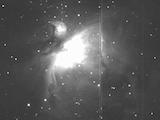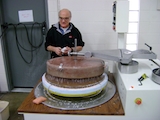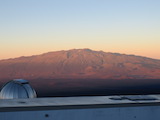ATLAS Update #11
2014 March 30
Since ATLAS achieved first light on December 12, 2013 with a prototype 7-inch Pathfinder telescope, it has successfully observed hundreds of main-belt asteroids. These were not new discoveries but the quality of the observations was good enough for them to be reported to the Minor Planet Center (MPC), the global center at Harvard for receiving and distributing information about asteroids, comets, and small moons of major planets.
TELESCOPE: We are pleased to report that construction is on track. The wide-field telescopes being built for ATLAS by DFM Engineering will make excellent images over a 7.5-degree field of view. The mirrors are being ground, the lenses are being fabricated, and the mechanical parts are designed and ready for the machine shop.
 CAMERA: Orion provided the first light image with the new "MicroCam3" 4x4k CCD camera on Tuesday, 25 Mar 2014 (right). The Takahashi telescope's 5 deg circular field of view illuminates twice as much sky area on the new camera relative to the 35mm camera it replaces. The CCDs will also be about 3 times more sensitive than the 35mm camera. The new setup has a filter wheel for color information
CAMERA: Orion provided the first light image with the new "MicroCam3" 4x4k CCD camera on Tuesday, 25 Mar 2014 (right). The Takahashi telescope's 5 deg circular field of view illuminates twice as much sky area on the new camera relative to the 35mm camera it replaces. The CCDs will also be about 3 times more sensitive than the 35mm camera. The new setup has a filter wheel for color information
While MicroCam3 has a 16-megapixel detector, the eventual ATLAS camera will have a 110-megapixel detector, which is housed in a cryostat to keep the detector cooled to -50° C.
When fully operational, the two-telescope ATLAS system will survey the sky four times each night and take around 3,000 images per night.
The detectors and CCD controllers for the final ATLAS system are being purchased. The ATLAS team is designing and building the cryostats.
WEATHER MONITORING: The ATLAS telescopes and domes are designed to work robotically with the goal of operating whenever the sky is dark and clear. To ensure maximum efficiency, this month the team has installed equipment to determine whether conditions are safe to open the domes and also created software to enable the equipment to judge if observations can go ahead and act accordingly.
The equipment includes a Boltwood cloud sensor that detects clouds, rain, temperature, humidity, and wind speed, plus a digital SLR camera with a fish-eye lens capable of imaging the whole sky at once. It quantifies the presence of clouds by whether known stars are visible or dimmed. This way, for example, ATLAS will know that if the eastern sky is cloudy, it should observe in the west.
SOFTWARE: Another exciting development is a plan to dramatically increase the bandwidth from Mauna Loa. This way, data can be downloaded almost immediately, thereby lowering the time between observing the sky and reporting the detection of asteroids to a few minutes. Ensuring all the ATLAS software programs communicate and run together is challenging. Programs include:
- Software that controls the robotic telescope
- Image acquisition software to make the observations
- Reduction software to make the image into something scientifically useful
- PHOTPIPE – a software program used by several observatories that compares the new image with old images to see if the object has been observed before
- Moving Object Pipeline Subsystem (MOPS), originally developed for Pan-STARRS, which actually detects asteroids and sends notification to the MPC.
All systems have to work together.
SITE & ENCLOSURE: By the end of 2014 we expect to have two observatories: one at the current location on Mauna Loa, Hawai’i Island, and a second on Haleakala, 100 miles northwest on Maui. Our telescope mounts and a second Ash-Dome are under construction.
PERSONNEL: We are advertising for a post doc (AAS #44787) and hope to bring someone on board within the next few months.
WEBSITE: This month we introduce our redesigned website at fallingstar.com
TO CONCLUDE: We’re very happy with our overall progress. We must be at full productivity in two years, and it’s impressive that the team is already able to find and report asteroids right now.



![[ATLAS Software Engineers Larry Denneau and Andrei Sherstyuk testing Pathfinder inside the Ash-Dome. Image credit: ATLAS.ifa.]](/media/weather-160.jpg)
![[ATLAS Principal Investigator John Tonry. Image credit: ATLAS.ifa.]](/media/Andre_mount_160.jpg)


